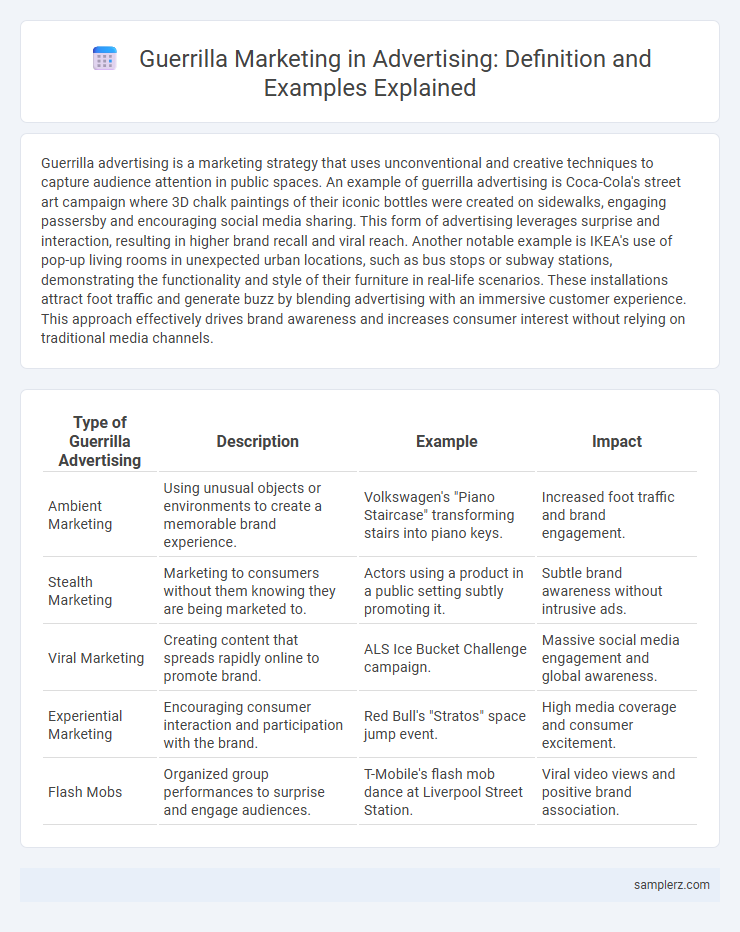Guerrilla advertising is a marketing strategy that uses unconventional and creative techniques to capture audience attention in public spaces. An example of guerrilla advertising is Coca-Cola's street art campaign where 3D chalk paintings of their iconic bottles were created on sidewalks, engaging passersby and encouraging social media sharing. This form of advertising leverages surprise and interaction, resulting in higher brand recall and viral reach. Another notable example is IKEA's use of pop-up living rooms in unexpected urban locations, such as bus stops or subway stations, demonstrating the functionality and style of their furniture in real-life scenarios. These installations attract foot traffic and generate buzz by blending advertising with an immersive customer experience. This approach effectively drives brand awareness and increases consumer interest without relying on traditional media channels.
Table of Comparison
| Type of Guerrilla Advertising | Description | Example | Impact |
|---|---|---|---|
| Ambient Marketing | Using unusual objects or environments to create a memorable brand experience. | Volkswagen's "Piano Staircase" transforming stairs into piano keys. | Increased foot traffic and brand engagement. |
| Stealth Marketing | Marketing to consumers without them knowing they are being marketed to. | Actors using a product in a public setting subtly promoting it. | Subtle brand awareness without intrusive ads. |
| Viral Marketing | Creating content that spreads rapidly online to promote brand. | ALS Ice Bucket Challenge campaign. | Massive social media engagement and global awareness. |
| Experiential Marketing | Encouraging consumer interaction and participation with the brand. | Red Bull's "Stratos" space jump event. | High media coverage and consumer excitement. |
| Flash Mobs | Organized group performances to surprise and engage audiences. | T-Mobile's flash mob dance at Liverpool Street Station. | Viral video views and positive brand association. |
Understanding Guerrilla Advertising: A Brief Overview
Guerrilla advertising leverages unconventional, low-cost tactics to capture audience attention in public spaces, such as Flash mobs or creative street art installations. Campaigns like Coca-Cola's "Small World Machines" connect strangers from different countries through interactive vending machines, sparking curiosity and emotional engagement. These inventive approaches maximize brand visibility and consumer interaction without relying on traditional media channels.
Street Art Campaigns: Creative Urban Engagement
Street art campaigns harness vibrant murals and graffiti in high-traffic urban areas to captivate audiences and foster brand recognition. Brands like Adidas and Coca-Cola have successfully used street art to create immersive, interactive experiences that blend creativity with marketing goals. This guerrilla advertising technique leverages public spaces to generate buzz and authentic community engagement.
Flash Mobs: Surprising Audiences in Public Spaces
Flash mobs in advertising create unexpected, choreographed performances in public spaces that captivate and engage audiences instantly. Brands like T-Mobile and Coca-Cola have utilized flash mobs to generate viral buzz and emotional connections, boosting brand visibility and consumer interaction. These spontaneous events leverage surprise and social sharing, making them a powerful guerrilla marketing tactic for memorable brand experiences.
Ambient Marketing: Blending Ads Into Everyday Life
Ambient marketing seamlessly integrates advertisements into everyday environments, transforming public spaces into interactive brand experiences. Examples include placing innovative ads on coffee cup sleeves, subway seats, or park benches that capture attention without disrupting the flow of daily life. This approach enhances brand recall and consumer engagement by embedding messages in familiar, unexpected contexts.
Interactive Installations: Engaging the Senses
Interactive installations in guerrilla advertising captivate audiences by engaging multiple senses, creating memorable brand experiences. Examples include tactile walls, immersive soundscapes, and scent diffusers that encourage direct consumer interaction. These sensory-rich environments boost brand recall and foster emotional connections by transforming passive viewers into active participants.
Viral Social Media Stunts: Online Guerrilla Tactics
Viral social media stunts exemplify guerrilla advertising through unexpected, creative campaigns designed to rapidly engage audiences and generate organic sharing across platforms like Instagram, TikTok, and Twitter. Brands such as Netflix gained significant traction with interactive challenges and immersive content that encouraged user participation and community-driven promotion. These online guerrilla tactics leverage trending hashtags, influencer partnerships, and real-time engagement metrics to maximize visibility and minimize advertising costs.
Experiential Marketing: Immersive Brand Experiences
Guerrilla advertising leverages experiential marketing by creating immersive brand experiences that engage consumers directly and memorably. Examples include pop-up events, interactive installations, and branded environments that encourage active participation and emotional connection. These tactics increase brand recall and foster deeper consumer loyalty through unique, hands-on interactions.
Product Placement in Unconventional Settings
Guerrilla marketing leverages product placement in unconventional settings to capture consumer attention and create memorable brand experiences. For example, placing branded coffee cups in unexpected urban art installations or embedding products within street performances transforms ordinary environments into dynamic advertising platforms. These creative tactics boost brand visibility and engagement by seamlessly integrating products into everyday life, sparking organic conversations.
Unexpected Brand Collaborations in Guerrilla Ads
Unexpected brand collaborations in guerrilla advertising create powerful buzz by combining distinct audiences, such as when IKEA and LEGO teamed up to showcase modular furniture with playful, buildable designs in public spaces. This unconventional partnership leveraged both brands' identities to capture attention and encourage social media sharing, enhancing engagement organically. By disrupting consumer expectations, these collaborations generate memorable experiences that amplify brand visibility and foster deeper emotional connections.
Measuring Success: Impact of Guerrilla Advertising
Guerrilla advertising success is measured through key performance indicators such as brand awareness uplift, social media engagement rates, and foot traffic increases at targeted locations. Metrics like viral reach and earned media value quantify the campaign's impact beyond traditional advertising spend. Analyzing consumer sentiment and sales conversions linked to the guerrilla effort provides critical insights into its overall effectiveness and ROI.

example of guerrilla in advertising Infographic
 samplerz.com
samplerz.com